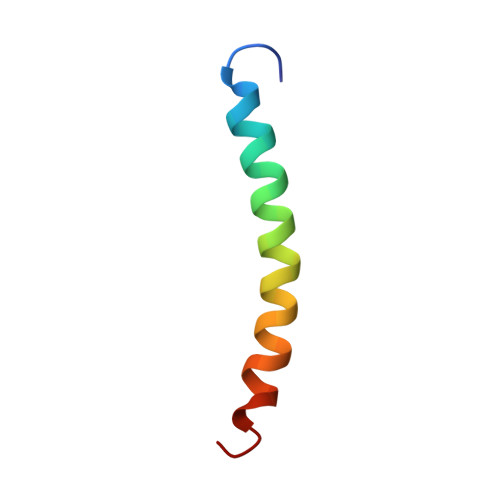Solution NMR Structure of the Junction between Tropomyosin Molecules: Implications for Actin Binding and Regulation.
Greenfield, N.J., Huang, Y.J., Swapna, G.V., Bhattacharya, A., Rapp, B., Singh, A., Montelione, G.T., Hitchcock-Degregori, S.E.(2006) J Mol Biology 364: 80-96
- PubMed: 16999976
- DOI: https://doi.org/10.1016/j.jmb.2006.08.033
- Primary Citation of Related Structures:
2G9J - PubMed Abstract:
Tropomyosin is a coiled-coil protein that binds head-to-tail along the length of actin filaments in eukaryotic cells, stabilizing them and providing protection from severing proteins. Tropomyosin cooperatively regulates actin's interaction with myosin and mediates the Ca2+ -dependent regulation of contraction by troponin in striated muscles. The N-terminal and C-terminal ends are critical functional determinants that form an "overlap complex". Here we report the solution NMR structure of an overlap complex formed of model peptides. In the complex, the chains of the C-terminal coiled coil spread apart to allow insertion of 11 residues of the N-terminal coiled coil into the resulting cleft. The plane of the N-terminal coiled coil is rotated 90 degrees relative to the plane of the C terminus. A consequence of the geometry is that the orientation of postulated periodic actin binding sites on the coiled-coil surface is retained from one molecule to the next along the actin filament when the overlap complex is modeled into the X-ray structure of tropomyosin determined at 7 Angstroms. Nuclear relaxation NMR data reveal flexibility of the junction, which may function to optimize binding along the helical actin filament and to allow mobility of tropomyosin on the filament surface as it switches between regulatory states.
- Department of Neuroscience and Cell Biology, Robert Wood Johnson Medical School, Piscataway, NJ 08854, USA. greenfie@umdnj.edu
Organizational Affiliation:

















